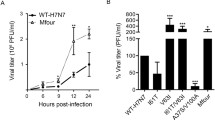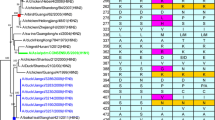Abstract
The N-terminal caspase cleavage in the nucleoprotein (NP) of influenza A virus is correlated with the host origin of the virus, thus could be a molecular determinant for host range. We studied how mutations targeting the NP cleavage motif of human and avian influenza viruses affect virus replication in vitro and in vivo. The “avian-like” D16→G substitution in the NP, which makes this protein resistant to cleavage, did not significantly affect the human A/Puerto Rico/8/34 (H1N1) virus replication in vitro but decreased the lethality of this virus in mice by 68-fold. Gene incompatibility contributed to the attenuated phenotype of the reassortant A/Puerto Rico/8/34 virus with avian NP derived from A/Teal/Hong Kong/w312/97 (H6N1) virus in vitro and in vivo. Insertion of the “human-like” G16→D mutation into avian NP, which resulted in susceptibility to caspase cleavage, did not rescue virulence, but made the reassortant virus even more attenuated. Introducing the human-like G16→D substitution into the NP of highly pathogenic A/Vietnam/1203/04 (H5N1) virus decreased lethality in mice. We confirmed that position 16, which associated with the N-terminal caspase cleavage of the NP, is important for optimal virus fitness in vitro and in vivo. An avian-like mutation at position 16 in the NP of human virus as well as a human-like substitution at this residue in avian NP both resulted in virus attenuation.




Similar content being viewed by others
References
Bean WJ (1984) Correlation of influenza A virus nucleoprotein genes with host species. Virology 133:438–442
Boulo S, Akarsu H, Ruigrok PWH, Baudin F (2007) Nuclear traffic of influenza virus proteins and ribonucleoprotein complexes. Virus Res 124:12–21
Buckler-White AJ, Murphy BR (1986) Nucleotide sequence analysis of the nucleoprotein gene of an avian and a human influenza virus strain identifies two classes of nucleoproteins. Virology 155:345–355
Capua I, Mutinelli F (2001) A color atlas and text on avian influenza. Papi Editore, Bologna
Gammelin M, Mandler J, Scholtissek C (1989) Two subtypes of nucleoproteins (NP) of influenza A viruses. Virology 170:71–80
Gog JR, Afonso Edos S, Dalton RM, Leclercq I, Tiley L, Elton D, von Kirchbach JC, Naffakh N, Escriou N, Digard P (2007) Codon conservation in the influenza A virus genome defines RNA packaging signals. Nucleic Acids Res 35:1897–1907
Gorman OT, Bean WJ, Kawaoka Y, Webster RG (1990) Evolution of the nucleoprotein gene of influenza A virus. J Virol 64:1487–1497
Hoffmann E, Neumann G, Kawaoka Y, Hobom G, Webster RG (2000) A DNA transfection system for generation of influenza A virus from eight plasmids. Proc Natl Acad Sci USA 97:6108–6113
Hoffmann E, Stech J, Guan Y, Webster RG, Perez DR (2001) Universal primer set for the full-length amplification of all influenza A viruses. Arch Virol 146:2275–2289
Hoffmann E, Krauss S, Perez D, Webby R, Webster RG (2002) Eight-plasmid system for rapid generation of influenza virus vaccines. Vaccine 20:3165–3170
Kuiken T, Holmes EC, McCauley J, Rimmelzwaan GF, Williams CS, Grenfell BT (2006) Host species barriers to influenza virus infections. Science 312:394–397
Lipatov AS, Andreansky S, Webby RJ, Hulse DJ, Rehg JE, Krauss S, Perez DR, Doherty PC, Webster RG, Sangster MY (2005) Pathogenesis of Hong Kong H5N1 influenza virus NS gene reassortants in mice: the role of cytokines and B- and T-cell responses. J Gen Virol 86:1121–1130
Neumann G, Kawaoka Y (2006) Host range restriction and pathogenicity in the context of influenza pandemic. Emerg Infect Dis 12:881–886
Osterhaus AD, Rimmelzwaan GF, Martina BE, Bestebroer TM, Fouchier RA (2000) Influenza B virus in seals. Science 288:1051–1053
Ozawa M, Fujii K, Muramoto Y, Yamada S, Yamayoshi S, Takada A, Goto H, Horimoto T, Kawaoka Y (2007) Contributions of two nuclear localization signals of influenza A virus nucleoprotein to viral replication. J Virol 81:30–41
Portela A, Digard P (2002) The influenza virus nucleoprotein: a multifunctional RNA-binding protein pivotal to virus replication. J Gen Virol 83:723–734
Reed LJ, Muench H (1938) A simple method for estimating fifty percent endpoints. Am J Hyg 27:493–497
Salomon R, Franks J, Govorkova EA, Ilyushina NA, Yen HL, Hulse-Post DJ, Humberd J, Trichet M, Rehg JE, Webby RJ, Webster RG, Hoffmann E (2006) The polymerase complex genes contribute to the high virulence of the human H5N1 influenza virus isolate A/Vietnam/1203/04. J Exp Med 203:689–697
Scholtissek C, Burger H, Kistner O, Shortridge KF (1985) The nucleoprotein as a possible major factor in determining host specificity of influenza H3N2 viruses. Virology 147:287–294
Snyder MH, Buckler-White AJ, London WT, Tierney EL, Murphy BR (1987) The avian influenza virus nucleoprotein gene and a specific constellation of avian and human virus polymerase genes each specify attenuation of avian-human influenza A/Pintail/79 reassortant viruses for monkeys. J Virol 61:2857–2863
Tian SF, Buckler-White AJ, London WT, Reck LJ, Chanock RM, Murphy BR (1985) Nucleoprotein and membrane protein genes are associated with restriction of replication of influenza A/Mallard/NY/78 virus and its reassortants in squirrel monkey respiratory tract. J Virol 53:771–775
Wang P, Palese P, O’Neill R.E (1997) The NPI-1/NPI-3 (karyopherin alpha) binding site on the influenza a virus nucleoprotein NP is a nonconventional nuclear localization signal. J Virol 71:1850–1856
Webster RG, Bean WJ, Gorman OT, Chambers TM, Kawaoka Y (1992) Evolution and ecology of influenza A viruses. Microbiol Mol Biol Rev 56:152–179
Wright PF, Webster RG (2001) Orthomyxoviruses. In: Knipe DM, Howley PM (eds) Fields virology. Lippincott Williams & Wilkins, Philadelphia, pp 1533–1579
Ye Q, Krug RM, Tao YJ (2006) The mechanism by which influenza A virus nucleoprotein forms oligomers and binds RNA. Nature 444:1078–1082
Yen HL, Monto AS, Webster RG, Govorkova EA (2005) Virulence may determine the necessary duration and dosage of oseltamivir treatment for highly pathogenic A/Vietnam/1203/04 influenza virus in mice. J Infect Dis 192:665–672
Yen HL, Herlocher LM, Hoffmann E, Matrosovich MN, Monto AS, Webster RG, Govorkova EA (2005) Neuraminidase inhibitor-resistant influenza viruses may differ substantially in fitness and transmissibility. Antimicrob Agents Chemother 49:4075–4084
Zhirnov OP, Bukrinskaya AG (1981) Two forms of influenza virus nucleoprotein in infected cells and virions. Virology 109:174–179
Zhirnov O, Bukrinskaya AG (1984) Nucleoproteins of animal influenza viruses, in contrast to those of human strains, are not cleaved in infected cells. J Gen Virol 65:1127–1134
Zhirnov OP (1988) The host origin of influenza A viruses can be assessed by the intracellular cleavage of the viral nucleocapsid protein. Arch Virol 99:277–284
Zhirnov OP, Konakova TE, Garten W, Klenk H (1999) Caspase-dependent N-terminal cleavage of influenza virus nucleocapsid protein in infected cells. J Virol 73:10158–10163
Zhirnov OP, Vorob’eva IV, Veselovskii EM, Klenk H (2003) Key role of Asp16 in proteolysis of influenza A NP protein by caspases in infected cells (in Russian). Vopr Virusol 48:8–14
Acknowledgments
We thank Jon P. Seiler for excellent technical assistance. Special thanks to Julia Cay Jones for editing the manuscript and Kristina S. Makarova for illustrations. This study was supported by NIAID contract AI-95357, by NIH Cancer Center Support (CORE) grant CA-21765, and by the American Lebanese Syrian Associated Charities (ALSAC).
Author information
Authors and Affiliations
Corresponding author
Additional information
These data have been presented in part at The 3rd Orthomyxovirus Research Conference, July 28–31, 2005. Queen’s College, Cambridge, UK.
Rights and permissions
About this article
Cite this article
Lipatov, A.S., Yen, HL., Salomon, R. et al. The role of the N-terminal caspase cleavage site in the nucleoprotein of influenza A virus in vitro and in vivo. Arch Virol 153, 427–434 (2008). https://doi.org/10.1007/s00705-007-0003-8
Received:
Accepted:
Published:
Issue Date:
DOI: https://doi.org/10.1007/s00705-007-0003-8




